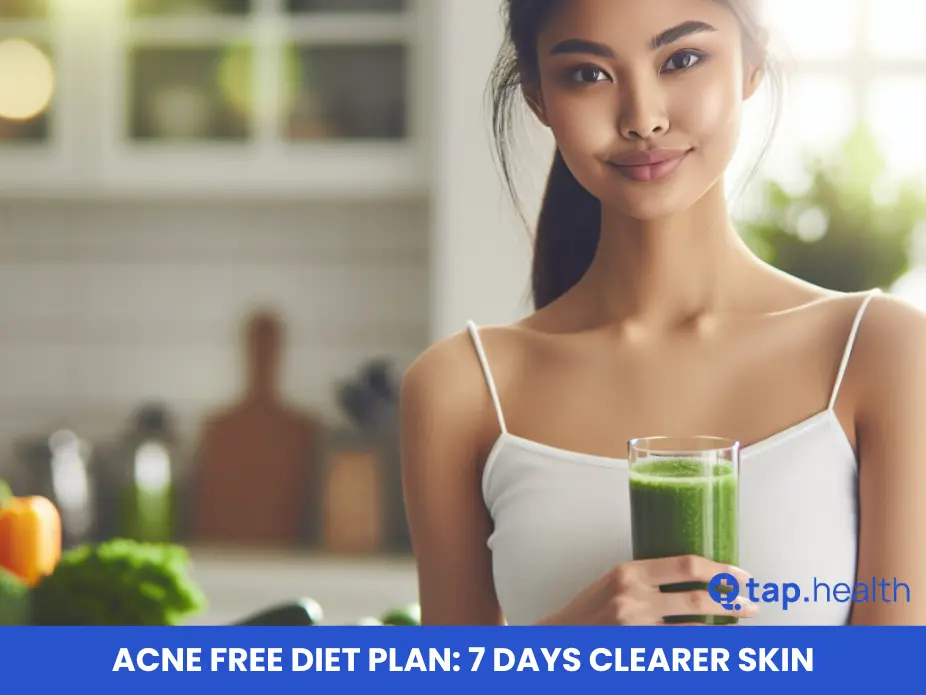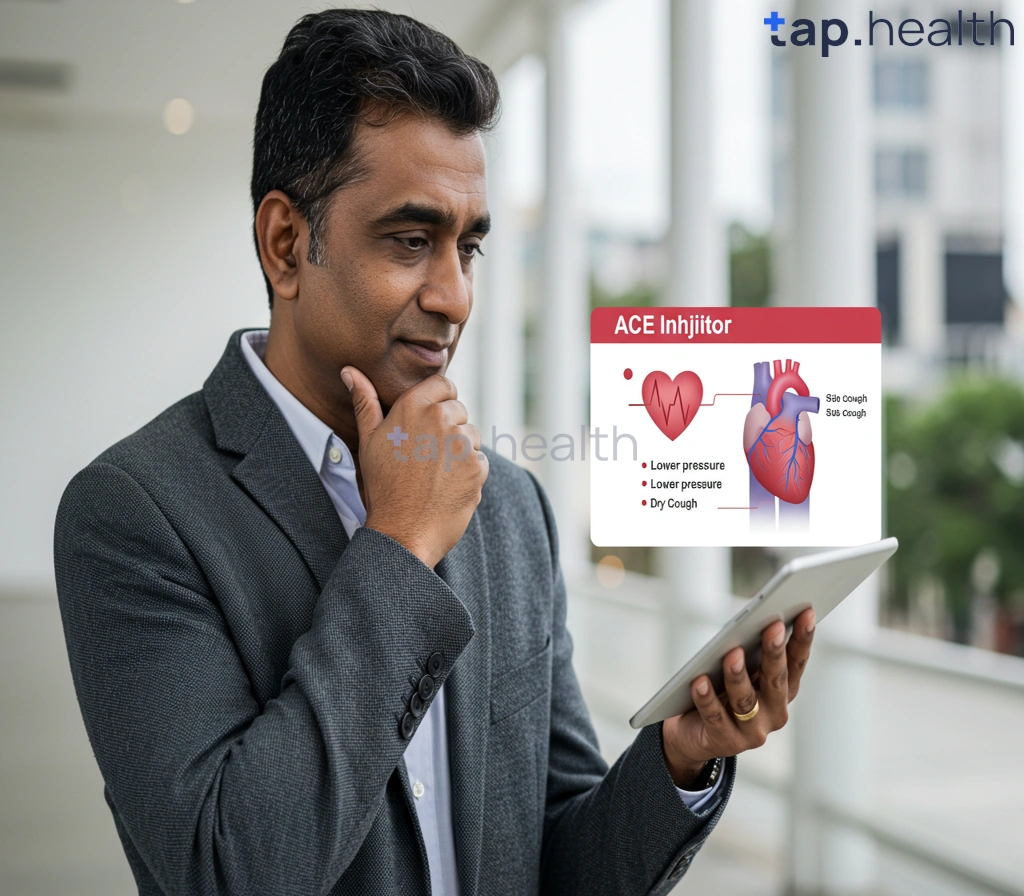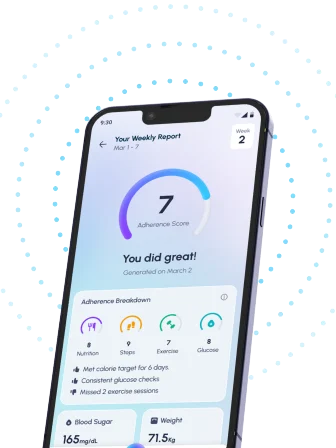Dealing with acne can be very annoying. A good skincare routine is important, but what you eat is also key. A focused diet plan can really help with your acne problems. This simple guide will look at how your diet and acne are connected. It will give you a clear 7-day plan to help you get healthier and clearer skin.
What is Acne?
Acne is a common skin condition that affects people of all ages. It happens when hair follicles get blocked by too much oil and dead skin cells. This blockage creates a place where bacteria can grow. This can lead to inflammation and result in pimples, whiteheads, and blackheads.
Genetics and hormonal changes are important in how acne develops. However, diet has also become a major factor that influences skin health.
Causes of Acne
Acne is a common skin condition. It happens when hair follicles get blocked by sebum, which is skin oil, and dead skin cells. The sebaceous glands make the oil. Sometimes, they produce too much, which mixes with dead skin and gets stuck in the follicles.
Different factors can lead to acne. These include genetics, hormonal changes during puberty, stress, and some medications. While we can’t always control these factors, we can change our diet. Choosing the right foods and adding specific nutrients can help our skin health.
By making better food choices, we can improve the condition of our skin. This can help us achieve a clearer complexion.
How Diet Influences Acne Development
The food we eat can make acne worse or better. It does this by affecting inflammation, hormones, and gut health. Foods that are high in sugar, like sugary drinks, white bread, and processed snacks, can quickly raise blood sugar levels. This leads to more insulin in the body and more oil production by the sebaceous glands.
Some people also find that dairy products can cause their acne to get worse. While we don’t know how this happens completely, some think that hormones in milk might increase oil production.
So, changing your diet is very important to help manage acne. By cutting out foods that trigger breakouts and focusing on a diet that has skin-friendly nutrients, you can take control of your skin’s health and aim for a clearer complexion.
Essential Nutrients to Combat Acne
When you are making a diet plan to get rid of acne, focus on adding foods that have important nutrients for good skin health. Look for omega-3 fatty acids found in fatty fish and flaxseeds. They help reduce inflammation and support overall skin health.
Vitamins and minerals are also key for clear skin. Vitamin C, zinc, and selenium are especially important. They act as antioxidants to protect skin cells from damage. They also help with collagen production, which keeps skin elasticity strong.
The Role of Omega-3 Fatty Acids
Omega-3 fatty acids are crucial for our health. Our bodies can’t make them, so we need to get them from our food or supplements. These healthy fats are great at lowering inflammation, which helps with acne.
They control sebum production, stopping the extra oil that can clog pores. Omega-3 fatty acids also support skin health by making cell membranes stronger and improving hydration. This leads to softer and more resilient skin.
Eating foods high in omega-3s can help a lot. You can include fatty fish like salmon, mackerel, and sardines. Also, try adding flaxseeds, chia seeds, and walnuts. These can really help you have clearer skin.
Vitamins and Minerals That Promote Clear Skin
Several vitamins and minerals are important for healthy skin and fighting acne.
- Vitamin C is a strong antioxidant. It protects skin cells from damage caused by free radicals. It also helps make collagen. This is important for skin elasticity and reducing acne scars.
- Zinc is another important mineral. It helps with wound healing and can reduce redness and swelling during breakouts. It controls oil production and helps with the normal shedding of dead skin cells to avoid clogged pores.
- Selenium is a trace mineral that is often not noticed. It has strong antioxidant qualities. It works together with vitamin E to protect cells from damage and supports healthy skin cell growth.
Foods to Embrace for an Acne-Free Life
A good acne-free diet plan is about eating foods that help your skin and lower inflammation. It’s important to include a wide range of colorful fruits and vegetables. These are full of antioxidants and vitamins that your skin needs.
Add foods with probiotics, like yogurt, kefir, or sauerkraut. These help keep your gut healthy, and a healthy gut is linked to good skin health. Also, choose whole grains such as brown rice and quinoa instead of white grains. This can help control blood sugar levels and stop insulin spikes that lead to breakouts.
Antioxidant-Rich Foods to Include
Antioxidants are great for keeping your skin safe from free radical damage. This type of damage can cause premature aging and worsen acne. Adding a variety of colorful fruits and vegetables to your meals can give your body important antioxidants. Here are some top choices to try:
- Berries: Blueberries, strawberries, raspberries, and blackberries have a lot of antioxidants like vitamin C and anthocyanins. These help protect skin cells and reduce inflammation.
- Citrus Fruits: Oranges, grapefruits, lemons, and limes are very good sources of vitamin C. They help your body make collagen and can keep your complexion bright.
- Green Tea: This tea is full of polyphenols, especially EGCG. Green tea has strong antioxidant and anti-inflammatory effects.
These antioxidants can shield your skin cells from damage, help in healing, and lead to a more even and healthy skin tone.
Probiotic Foods for Gut Health and Clear Skin
The gut microbiome is made up of trillions of bacteria living in our digestive system. It is very important for our overall health and even affects the health of our skin. Recent studies show a strong connection between gut health and skin problems like acne.
Probiotics are the good bacteria in our gut. They help keep our microbiome balanced and support the lining of our gut. This can lower inflammation in our body, including our skin.
To support a healthy gut microbiome, you can add probiotic-rich foods to your diet. Some examples are yogurt with live and active cultures, kefir, kimchi, sauerkraut, and tempeh. Eating these foods might help you get clearer skin.
Foods to Avoid for Acne Prevention
While adding good foods is important for a diet that helps with acne, it is just as important to cut back or stay away from foods that can cause breakouts. Foods with a high glycemic index, like sugary drinks, snacks, and refined grains, can quickly raise blood sugar. This leads to more inflammation and oil production in the skin.
Dairy products, especially cow’s milk, may also cause acne in some people because of certain hormones in them. Plus, eating less saturated and trans fats, which are often in fried and processed foods, can help keep inflammation under control and support better skin health.
Identifying High-Glycemic Index Foods
Knowing how different foods affect your blood sugar is important for an acne-free diet. Foods with a high glycemic index (GI) digest quickly. This causes blood sugar levels to rise quickly. Such changes can trigger hormones that may worsen acne.
Sugary drinks, processed snacks, white bread, and pasta are common high-GI foods. Eating these can cause insulin levels to spike. Insulin regulates blood sugar, but it can also make sebaceous glands produce more oil. This oil can clog pores and lead to breakouts.
Choosing low-GI options, like whole grains, legumes, and fruits and veggies rich in fiber, can help keep blood sugar steady. This can reduce insulin spikes and help promote clearer skin.
Dairy and Processed Foods: What to Know
The link between dairy products and acne is still being studied. However, many people notice their skin improves after they reduce or cut out dairy from their diet. Dairy contains hormones, even organic ones, that might affect our hormones and raise oil production.
Processed foods are full of refined sugars, bad fats, and artificial ingredients. These can cause inflammation in the body. Inflammation plays a big role in acne since it makes redness, swelling, and pimples worse.
By cutting back on processed foods, you can lower inflammation. This helps control blood sugar and creates a better balance inside your body. All of this supports healthy skin.
Beginner’s Guide to Starting Your Acne-Free Diet Plan
Embarking on a diet plan for acne may look tough, but it is a simple process. Begin by spotting foods in your meals that could trigger acne. Then, slowly switch these out for foods that are good for your skin.
Don’t look for quick fixes; let your body adjust to these dietary changes. It may take a few weeks before you notice clear changes in your skin. Remember, being consistent is very important. Stick to your new eating habits to enjoy the long-term benefits of clear and healthy skin.
Preparing Your Kitchen and Pantry
The key to a good acne-free diet plan is to make your kitchen a helpful place. Start by removing tempting processed foods, sugary drinks, and unhealthy snacks. Instead, add whole grains like brown rice, quinoa, and oats. These give you lasting energy without making blood sugar levels rise too fast.
Fill your fridge with fresh fruits, vegetables, and leafy greens. Try to get different colors to make sure you eat lots of antioxidants and important nutrients. Add healthy fats too, like avocados, nuts, seeds, and olive oil. These are important for good skin health and keeping hormones balanced.
When you have healthy options ready, you will be less likely to grab those tempting trigger foods. You will want to choose better foods for your skin instead.
Understanding Food Labels and Ingredients
Navigating food labels can be tough. However, it’s important for choosing the right foods for an acne-free diet. Focus more on the ingredient list. Don’t just look at the calories or fat. Choose products with simple, whole-food ingredients. Steer clear of items that contain many hard-to-read additives, preservatives, and fake sweeteners.
Sugar may show up under different names on food labels. Some of these names are high-fructose corn syrup, dextrose, maltose, and sucrose. Watch out for these hidden sugars. It’s best to pick products with little to no added sugars.
Remember this: knowledge helps you pick the best foods for your skin.
Step-by-Step Guide to Creating Your 7-Day Plan
Creating a good 7-day acne-free diet plan needs to fit your likes and any food allergies you might have. Start by cutting out foods that can trigger acne, such as dairy, sugary snacks, and processed foods for one or two weeks. This will help you see any changes in your skin.
Then, slowly add foods that can help heal your skin. Look for ones high in omega-3 fatty acids, antioxidants, and probiotics. Remember to be consistent with your diet. Make small changes instead of big ones. This way, you can enjoy long-term success.
Step 1: Eliminate Acne Trigger Foods
The first step to an acne-free diet is to cut out or clearly reduce foods that can cause breakouts. Dairy products, especially cow’s milk, have hormones. These hormones can increase oil production and worsen acne for some people.
Foods and drinks with high sugar, like candy, pastries, sweet drinks, and snacks, can quickly raise your blood sugar. This can lead to more inflammation and more oil production. It clogs pores and causes breakouts.
If you stop or reduce these trigger foods for a week or two, you can give your body the chance to reset. You might see positive changes in your skin.
Step 2: Incorporate Skin-Healing Foods
Once you have taken a break from foods that might trigger issues, it’s time to add lots of skin-helping nutrients to your meals. Omega-3 fatty acids are found in fatty fish such as salmon, mackerel, and sardines. You can also get them from flaxseeds and chia seeds. These fatty acids have strong benefits that can help reduce acne.
Increase your intake of antioxidants by eating colorful fruits and vegetables. Berries, citrus fruits, and leafy greens are especially helpful. Antioxidants protect your skin cells from damage and help produce collagen. This keeps your skin elasticity in good shape and helps you look younger.
Remember to include probiotics too! You can do this by adding yogurt with live cultures, kefir, or fermented foods like sauerkraut and kimchi to your meals. A healthy gut microbiome is closely linked to skin health.
Step 3: Planning Your Meals for the Week
Planning meals is crucial to stay consistent with your acne-free diet plan. Begin by creating a simple structure for your meals, ensuring a balance of lean protein, healthy fats, and complex carbohydrates from whole grains.
Here’s a sample meal plan to get you started:
| Day | Breakfast | Lunch | Dinner |
| Day 1 | Oatmeal with Berries & Almonds | Lentil Soup with Side Salad | Salmon with Roasted Vegetables |
| Day 2 | Greek Yogurt with Fruit & Nuts | Quinoa Salad with Grilled Chicken | Tofu Stir-Fry with Brown Rice |
| Day 3 | Smoothie with Spinach & Berries | Leftover Tofu Stir-Fry | Turkey Meatballs with Zucchini Noodles |
| Day 4 | Eggs with Avocado & Whole Grain | Leftover Turkey Meatballs | Chickpea & Vegetable Curry |
| Day 5 | Chia Seed Pudding with Berries | Salad with Grilled Salmon | Lentil & Vegetable Stew |
| Day 6 | Leftover Lentil & Vegetable Stew | Quinoa Salad with Chickpeas & Avocado | Leftover Chickpea and Vegetable Curry |
| Day 7 | Smoothie with Kale & Mango | Leftover Salad | Turkey Breast with Roasted Broccoli |
Feel free to adjust this plan based on your dietary needs and preferences.
Aldo read this- 30 Days Acne Free Diet Plan for Clearer Skin
Step 4: Monitoring Your Skin’s Response
As you start your journey to clear skin, pay close attention to your body. Check how your skin reacts to the foods you eat. Keep a journal where you write down your meals, snacks, and any changes in your skin. Look for breakouts, redness, or dryness.
This will help you find any foods that might be causing problems again. You may also see what parts of your diet need more changes. It is important to be patient because your skin may take time to improve with healthy eating.
Remember, changing your diet will not clear up acne overnight. But if you keep feeding your body good foods and spot any trigger foods, you can make progress toward clearer skin and better overall health.
Daily Meal Planning Tips for Clear Skin
When you plan your daily meals for clear skin, focus on whole and unprocessed foods. Add lots of colorful fruits and vegetables. Try to eat at least five servings each day. These foods are full of antioxidants. They help protect your skin from damage and reduce inflammation.
Pick lean protein options like fish, poultry, beans, lentils, or tofu. These help your cells grow and repair. Choose healthy fats such as avocados, nuts, seeds, and olive oil. These can help balance hormones and keep skin elasticity. Remember, making small changes over time can bring the best results for your skin’s health.
Hydration: The Key to Enhancing Your Diet’s Effectiveness
Hydration is very important for clear skin. When you’re low on water, your skin may lose its bounce, feel dry, and get more breakouts. Drinking plenty of water each day helps get rid of toxins. It also keeps your skin cells full of moisture and gives you a natural glow.
You should include fruits and vegetables with high water content in your meals. Watermelon, cucumber, spinach, and celery are great options. Carry a reusable water bottle to remind yourself to drink more water.
Try to drink at least eight glasses of water every day. You may need to drink more if you are active or live in a hot area. Good hydration along with a balanced diet can greatly improve the look and health of your skin.
Easy-to-Prepare Acne-Friendly Recipes
Finding time to prepare big meals isn’t always easy, but you can still include acne-friendly meals in your daily life without stress. Start your morning with a healthy smoothie. Just blend spinach, berries, almond milk, and some protein powder. It’s quick and tasty.
For lunch, make a simple salad with grilled chicken or tofu, avocado, and colorful veggies. Dinner can be as easy as baking salmon or roasting vegetables with quinoa or brown rice on the side.
Keep some healthy snacks, like sliced fruits, veggies with hummus, or a handful of almonds. These can help you fight cravings between meals. Remember, focusing on good, whole foods can be simple and doesn’t need to take a lot of time.
Lifestyle Modifications to Support Your Diet Plan
Diet is important for managing acne, but lifestyle changes can also help your skin. Regular exercise is good. It lowers stress, boosts circulation, and helps get rid of toxins, which all support clearer skin.
Managing stress is also key. You can try yoga, meditation, or just spend time outside. Stress can make your hormones go out of balance, which increases oil production and worsens acne breakouts.
Importance of Regular Exercise
The advantages of regular exercise go beyond just losing weight and getting fit. Exercise is also important for keeping your skin healthy. When you work out, your heart beats faster. This boosts blood flow all over your body, including your skin.
The better blood circulation brings oxygen and nutrients to your skin cells. It also helps remove waste products and toxins from your body. Exercise can reduce stress, which often causes acne flare-ups. It does this by lowering cortisol levels.
Additionally, when you sweat while exercising, it helps clean your pores. This removes dirt, oil, and bacteria that can lead to breakouts. Try to exercise for at least 30 minutes most days of the week. You can choose activities like brisk walking, jogging, cycling, or swimming. Live an active life to enjoy clearer and healthier skin.
Stress Management Techniques
Stress affects our whole body, including our skin. When we feel stress, our bodies make cortisol. This hormone can cause problems for our skin. Cortisol can increase oil production, harm the skin’s protective barrier, and make issues like acne worse.
So, managing stress is important for better skin. You should add some stress-reducing activities to your day. Try meditation, deep breathing exercises, yoga, or spending time outdoors.
Find something that helps you relax, like reading, listening to music, or being with family and friends. Taking care of your mind is as important as taking care of your body. This helps you feel better overall, which shows in your skin’s clarity.
Frequently Asked Questions
1.Can a diet change alone cure my acne?
A change in diet alone will not completely cure acne. However, it can greatly help skin health. This happens by reducing inflammation, controlling hormones, and lowering triggers for acne.
2.How quickly can I expect to see results from this diet plan?
Many people see improvements in their skin health after a few weeks of sticking to the diet plan. It is important to be patient and keep going. Getting clear skin takes time and is not something that happens overnight.
3.Are there any specific supplements that can enhance my diet’s effectiveness for acne?
Eating foods that are full of nutrients is very important. Supplements can also help. Omega-3 fatty acids, probiotics, and zinc are good examples. They can support skin health and help prevent acne. You can get the best results when you combine these supplements with a healthy diet.




